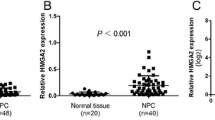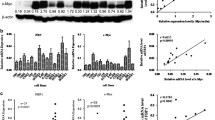Abstract
Our previous study showed that knockdown of high-mobility group A2 (HMGA2) could suppress nasopharyngeal carcinoma (NPC) cell migration, invasion, and epithelial–mesenchymal transition (EMT) process, and HMGA2 is a direct functional target of let-7 to regulate NPC cell migration, invasion, and EMT process. However, little is known about the clinical and prognostic significance of HMGA2 protein in NPC patients. The purpose of this study is to identify the clinical and prognostic roles of HMGA2 in NPC patients. We initially analyzed the microarray data and verified mRNA and protein levels of HMGA2 in NPC tissues. Immunohistochemical staining for HMGA2 protein was performed in 116 NPC patients. The associations between HMGA2 protein expression and clinicopathologic features and its prognostic significance were analyzed. In our results, we found mRNA and protein expressions of HMGA2 were upregulated in NPC tissues and cell lines. In 116 NPC tissue samples, we observed that HMGA2 protein overexpression was associated with clinical stage, lymph node metastasis, and distant metastasis. Moreover, NPC patients with high levels of HMGA2 protein expression had shorter overall survival in comparison to patients with low levels of HMGA2 protein. In multivariate analysis, HMGA2 protein overexpression was an unfavorable prognostic factor for NPC patients. In conclusion, HMGA2 is an important biomarker to predicting NPC patient’s survival time.



Similar content being viewed by others
References
Torre LA, Bray F, Siegel RL, Ferlay J, Lortet-Tieulent J, Jemal A (2015) Global cancer statistics, 2012. CA 65(2):87–108. doi:10.3322/caac.21262
Wei WI, Sham JS (2005) Nasopharyngeal carcinoma. Lancet 365(9476):2041–2054. doi:10.1016/S0140-6736(05)66698-6
Zhang L, Zhu YX, Wang Y, Huang CP, Wu Y, Ji QH (2011) Salvage surgery for neck residue or recurrence of nasopharyngeal carcinoma: a 10-year experience. Ann Surg Oncol 18(1):233–238. doi:10.1245/s10434-010-1292-9
Hock R, Furusawa T, Ueda T, Bustin M (2007) HMG chromosomal proteins in development and disease. Trends Cell Biol 17(2):72–79. doi:10.1016/j.tcb.2006.12.001
Pallante P, Sepe R, Puca F, Fusco A (2015) High mobility group a proteins as tumor markers. Front Med 2:15. doi:10.3389/fmed.2015.00015
Morishita A, Zaidi MR, Mitoro A, Sankarasharma D, Szabolcs M, Okada Y, D’Armiento J, Chada K (2013) HMGA2 is a driver of tumor metastasis. Cancer Res 73(14):4289–4299. doi:10.1158/0008-5472.CAN-12-3848
Ma C, Nong K, Zhu H, Wang W, Huang X, Yuan Z, Ai K (2014) H19 promotes pancreatic cancer metastasis by derepressing let-7’s suppression on its target HMGA2-mediated EMT. Tumour Biol 35(9):9163–9169. doi:10.1007/s13277-014-2185-5
Liu Q, Liu T, Zheng S, Gao X, Lu M, Sheyhidin I, Lu X (2014) HMGA2 is down-regulated by microRNA let-7 and associated with epithelial-mesenchymal transition in oesophageal squamous cell carcinomas of Kazakhs. Histopathology 65(3):408–417. doi:10.1111/his.12401
Ding X, Wang Y, Ma X, Guo H, Yan X, Chi Q, Li J, Hou Y, Wang C (2014) Expression of HMGA2 in bladder cancer and its association with epithelial-to-mesenchymal transition. Cell Prolif 47(2):146–151. doi:10.1111/cpr.12096
Yu H, Lim HH, Tjokro NO, Sathiyanathan P, Natarajan S, Chew TW, Klonisch T, Goodman SD, Surana U, Droge P (2014) Chaperoning HMGA2 protein protects stalled replication forks in stem and cancer cells. Cell Rep 6(4):684–697. doi:10.1016/j.celrep.2014.01.014
Wei J, Li H, Wang S, Li T, Fan J, Liang X, Li J, Han Q, Zhu L, Fan L, Zhao RC (2014) let-7 enhances osteogenesis and bone formation while repressing adipogenesis of human stromal/mesenchymal stem cells by regulating HMGA2. Stem Cells Dev 23(13):1452–1463. doi:10.1089/scd.2013.0600
Wu A, Wu K, Li J, Mo Y, Lin Y, Wang Y, Shen X, Li S, Li L, Yang Z (2015) Let-7a inhibits migration, invasion and epithelial-mesenchymal transition by targeting HMGA2 in nasopharyngeal carcinoma. J Transl Med 13(1):105. doi:10.1186/s12967-015-0462-8
Wu A, Wu K, Li M, Bao L, Shen X, Li S, Li J, Yang Z (2015) Upregulation of microRNA492 induced by epigenetic drug treatment inhibits the malignant phenotype of clear cell renal cell carcinoma in vitro. Mol Med Rep 12(1):1413–1420. doi:10.3892/mmr.2015.3550
Wang YZ, Wu KP, Wu AB, Yang ZC, Li JM, Mo YL, Xu M, Wu B, Yang ZX (2014) MMP-14 overexpression correlates with poor prognosis in non-small cell lung cancer. Tumour Biol 35(10):9815–9821. doi:10.1007/s13277-014-2237-x
Tu L, Liu Z, He X, He Y, Yang H, Jiang Q, Xie S, Xiao G, Li X, Yao K, Fang W (2010) Over-expression of eukaryotic translation initiation factor 4 gamma 1 correlates with tumor progression and poor prognosis in nasopharyngeal carcinoma. Mol Cancer 9:78. doi:10.1186/1476-4598-9-78
Chiappetta G, Bandiera A, Berlingieri MT, Visconti R, Manfioletti G, Battista S, Martinez-Tello FJ, Santoro M, Giancotti V, Fusco A (1995) The expression of the high mobility group HMGI (Y) proteins correlates with the malignant phenotype of human thyroid neoplasias. Oncogene 10(7):1307–1314
Rogalla P, Drechsler K, Frey G, Hennig Y, Helmke B, Bonk U, Bullerdiek J (1996) HMGI-C expression patterns in human tissues. Implications for the genesis of frequent mesenchymal tumors. Am J Pathol 149(3):775–779
Hirning-Folz U, Wilda M, Rippe V, Bullerdiek J, Hameister H (1998) The expression pattern of the Hmgic gene during development. Genes Chromosom Cancer 23(4):350–357
Guo L, Chen C, Shi M, Wang F, Chen X, Diao D, Hu M, Yu M, Qian L, Guo N (2013) Stat3-coordinated Lin-28-let-7-HMGA2 and miR-200-ZEB1 circuits initiate and maintain oncostatin M-driven epithelial-mesenchymal transition. Oncogene 32(45):5272–5282. doi:10.1038/onc.2012.573
Rogalla P, Drechsler K, Kazmierczak B, Rippe V, Bonk U, Bullerdiek J (1997) Expression of HMGI-C, a member of the high mobility group protein family, in a subset of breast cancers: relationship to histologic grade. Mol Carcinog 19(3):153–156
Sarhadi VK, Wikman H, Salmenkivi K, Kuosma E, Sioris T, Salo J, Karjalainen A, Knuutila S, Anttila S (2006) Increased expression of high mobility group A proteins in lung cancer. J Pathol 209(2):206–212. doi:10.1002/path.1960
Meyer B, Loeschke S, Schultze A, Weigel T, Sandkamp M, Goldmann T, Vollmer E, Bullerdiek J (2007) HMGA2 overexpression in non-small cell lung cancer. Mol Carcinog 46(7):503–511. doi:10.1002/mc.20235
Belge G, Meyer A, Klemke M, Burchardt K, Stern C, Wosniok W, Loeschke S, Bullerdiek J (2008) Upregulation of HMGA2 in thyroid carcinomas: a novel molecular marker to distinguish between benign and malignant follicular neoplasias. Genes Chromosom Cancer 47(1):56–63. doi:10.1002/gcc.20505
Jang MH, Jung KC, Min HS (2015) The diagnostic usefulness of HMGA2, survivin, CEACAM6, and SFN/14-3-3 delta in follicular thyroid carcinoma. J Pathol Transl Med 49(2):112–117. doi:10.4132/jptm.2015.01.31
Raskin L, Fullen DR, Giordano TJ, Thomas DG, Frohm ML, Cha KB, Ahn J, Mukherjee B, Johnson TM, Gruber SB (2013) Transcriptome profiling identifies HMGA2 as a biomarker of melanoma progression and prognosis. J Investig Dermatol 133(11):2585–2592. doi:10.1038/jid.2013.197
Abe N, Watanabe T, Suzuki Y, Matsumoto N, Masaki T, Mori T, Sugiyama M, Chiappetta G, Fusco A, Atomi Y (2003) An increased high-mobility group A2 expression level is associated with malignant phenotype in pancreatic exocrine tissue. Br J Cancer 89(11):2104–2109. doi:10.1038/sj.bjc.6601391
Liang JW, Shi ZZ, Shen TY, Che X, Wang Z, Shi SS, Xu X, Cai Y, Zhao P, Wang CF, Zhou ZX, Wang MR (2014) Identification of genomic alterations in pancreatic cancer using array-based comparative genomic hybridization. PLoS One 9(12):e114616. doi:10.1371/journal.pone.0114616
Miyazawa J, Mitoro A, Kawashiri S, Chada KK, Imai K (2004) Expression of mesenchyme-specific gene HMGA2 in squamous cell carcinomas of the oral cavity. Cancer Res 64(6):2024–2029
Motoyama K, Inoue H, Nakamura Y, Uetake H, Sugihara K, Mori M (2008) Clinical significance of high mobility group A2 in human gastric cancer and its relationship to let-7 microRNA family. Clin Cancer Res 14(8):2334–2340. doi:10.1158/1078-0432.CCR-07-4667
Yang GL, Zhang LH, Bo JJ, Hou KL, Cai X, Chen YY, Li H, Liu DM, Huang YR (2011) Overexpression of HMGA2 in bladder cancer and its association with clinicopathologic features and prognosis HMGA2 as a prognostic marker of bladder cancer. Eur J Surg Oncol 37(3):265–271. doi:10.1016/j.ejso.2011.01.004
Mu G, Liu H, Zhou F, Xu X, Jiang H, Wang Y, Qu Y (2010) Correlation of overexpression of HMGA1 and HMGA2 with poor tumor differentiation, invasion, and proliferation associated with let-7 down-regulation in retinoblastomas. Hum Pathol 41(4):493–502. doi:10.1016/j.humpath.2009.08.022
Lee CT, Zhang L, Mounajjed T, Wu TT (2013) High mobility group AT-hook 2 is overexpressed in hepatoblastoma. Hum Pathol 44(5):802–810. doi:10.1016/j.humpath.2012.08.003
Li Y, Zhao Z, Xu C, Zhou Z, Zhu Z, You T (2014) HMGA2 induces transcription factor Slug expression to promote epithelial-to-mesenchymal transition and contributes to colon cancer progression. Cancer Lett 355(1):130–140. doi:10.1016/j.canlet.2014.09.007
Thuault S, Valcourt U, Petersen M, Manfioletti G, Heldin CH, Moustakas A (2006) Transforming growth factor-beta employs HMGA2 to elicit epithelial-mesenchymal transition. J Cell Biol 174(2):175–183. doi:10.1083/jcb.200512110
Thuault S, Tan EJ, Peinado H, Cano A, Heldin CH, Moustakas A (2008) HMGA2 and Smads co-regulate SNAIL1 expression during induction of epithelial-to-mesenchymal transition. J Biol Chem 283(48):33437–33446. doi:10.1074/jbc.M802016200
Qian ZR, Asa SL, Siomi H, Siomi MC, Yoshimoto K, Yamada S, Wang EL, Rahman MM, Inoue H, Itakura M, Kudo E, Sano T (2009) Overexpression of HMGA2 relates to reduction of the let-7 and its relationship to clinicopathological features in pituitary adenomas. Mod Pathol 22(3):431–441. doi:10.1038/modpathol.2008.202
Lee J, Ha S, Jung CK, Lee HH (2015) High-mobility-group A2 overexpression provokes a poor prognosis of gastric cancer through the epithelial-mesenchymal transition. Int J Oncol. doi:10.3892/ijo.2015.2947
Liu B, Pang B, Hou X, Fan H, Liang N, Zheng S, Feng B, Liu W, Guo H, Xu S, Pang Q (2014) Expression of high-mobility group AT-hook protein 2 and its prognostic significance in malignant gliomas. Hum Pathol 45(8):1752–1758. doi:10.1016/j.humpath.2014.02.028
Wu L, Wang Z, Lu R, Jiang W (2012) Expression of high mobility group A2 is associated with poor survival in hepatocellular carcinoma. Pathol Oncol Res 18(4):983–987. doi:10.1007/s12253-012-9514-z
Xia YY, Yin L, Tian H, Guo WJ, Jiang N, Jiang XS, Wu J, Chen M, Wu JZ, He X (2015) HMGA2 is associated with epithelial-mesenchymal transition and can predict poor prognosis in nasopharyngeal carcinoma. OncoTargets Ther 8:169–176. doi:10.2147/OTT.S74397
Kong D, Su G, Zha L, Zhang H, Xiang J, Xu W, Tang Y, Wang Z (2014) Coexpression of HMGA2 and Oct4 predicts an unfavorable prognosis in human gastric cancer. Med Oncol 31(8):130. doi:10.1007/s12032-014-0130-5
Califano D, Pignata S, Losito NS, Ottaiano A, Greggi S, De Simone V, Cecere S, Aiello C, Esposito F, Fusco A, Chiappetta G (2014) High HMGA2 expression and high body mass index negatively affect the prognosis of patients with ovarian cancer. J Cell Physiol 229(1):53–59. doi:10.1002/jcp.24416
Acknowledgments
This work was supported by the funding from the National Natural Science Foundation of China (No. 81201672), the Doctoral Program of Affiliated Hospital of Guangdong Medical College (No. BK201208), and the Science and Technology Planning Project of Guangdong Province (No. 2013B021800078).
Author information
Authors and Affiliations
Corresponding authors
Ethics declarations
Conflicts of interest
None.
Rights and permissions
About this article
Cite this article
Liu, Z., Wu, K., Yang, Z. et al. High-mobility group A2 overexpression is an unfavorable prognostic biomarker for nasopharyngeal carcinoma patients. Mol Cell Biochem 409, 155–162 (2015). https://doi.org/10.1007/s11010-015-2521-0
Received:
Accepted:
Published:
Issue Date:
DOI: https://doi.org/10.1007/s11010-015-2521-0




